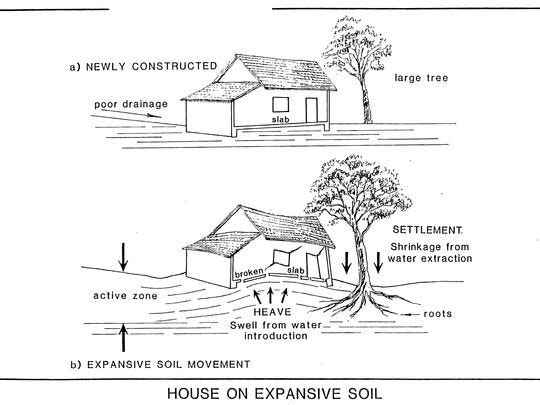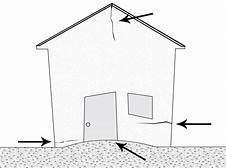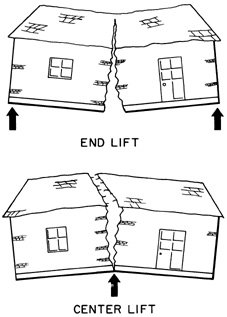Preventing, Stopping and Reversing Foundation Problems

Foundation damage and failure do not just happen. Sheetrock does not crack spontaneously, bricks don't just snap and doors and windows do not jump out of square. The supporting earth becomes unsupportive. To prevent, stop or reverse these issues the cause of the soil movement must be determined and rectified...correctly.
If expanding soils cause an area of a building to heave (be lifted) and piers are used to lift the rest of the building to the level of the heave, it can look great until the soil dries and returns to original elevation. When the heaved section of the building goes down and the "repaired" or piered parts stay up, the position of the damage reverses and the rest of the building must be piered, including unsupported interior sections. These additional piers are a new large expense to the owner and stress to the structure.
The major cause of foundation movement in North Texas and much of the U. S. are the shrinking and swelling of soils. While these effects are not usually near as disastrous as those shown in the pictures above they can be highly inconvenient and extremely costly.
Contrary to popular opinion foundation movement that leads to foundation distress is more often soils expanding and causing upheaval. You see concrete is seldom poured in moist soil, so foundations are often poured when soils are contracted. After the foundation is poured the structure is constructed as close to square and plumb as is practical. As the weather changes and the rains come the soils expands often unevenly around and under the foundation. At this point the foundations will flex, as they are designed to do and the building materials will not flex because they are, for the most part rigid As the soil moves the foundation there goes the square and plumb, here comes the cracks, out of square doors and windows and tilted floors.


Drawing showing flex and distortion.

Upheaval
Buildings that have experienced upheaval do not respond well to piers. Later on I will explain why.
Now don't get me wrong about expanding and contracting soils. It is not uncommon for foundations to also settle as soils shrink under the structure. It doesn't happen as often as upheaval, or expanding soils but it does happen and when it happens the signs are similar to that of upheaval. Signs are similar...whether settling or upheaval but the cures are vastly different in methods, cost, and success.
Here lies the problem: For a successful foundation repair, the repair must identify the cause, AND, the cure must eliminate the cause. Now in the case of soil shake or soil loss such as earthquakes and subsidence piers may be required to stabilize structurally damaged areas. In situations like sinkholes, piers are usually required to provide support and lift along with the addition of soil to fill voids. With severe erosion, once again piers are usually used to reposition the building but additional soil is often required to fill voids and more than occasionally a properly constructed retaining wall will provide insurance against repeated failure.
Now we come to settlement and upheaval. These problems, I would think, based on my forty years of experience in the foundation industry amounts to about 85% of foundation caused damage in North Texas, central Texas, South Texas and much surrounding area. This is based on climate, rolling hills and soil composition, the three major elements that conspire to make the soil move and in turn, foundation caused issues to develop. I would additionally say that at least 70% of that 85% would be the result of upheaval.
The fact that many of the foundation repair companies in these areas sell piers as their main profit center lead to the percentage of failed foundation repairs to be so high. Piers are not nearly the major answer to foundation problems in this area, and when they are, the right piers (their are at least fifteen varieties available in our area of concern) must be used.
Cost of piers in the area can run anywhere from around $200 per pier, up to $700+ for the same type of piers. For some custom designs, and or for lifting extra weight and for out of area jobs the price may vary widely. It is also not unusual for foundation repair salespeople to load customers up with un-needed piers.
The usual cause of expanding soils lifting a structure to the point of experiencing upheaval is the introduction of moisture to the soil. The moisture can come from several places including, rain water, leaking sewer lines under the house, leaking incoming domestic drinking water lines, a faucet dripping, a leak in a irrigation system, a leaking swimming pool a leaking line from the pool to the pool equipment, a neighbor draining their pool, city water and/or sewer lines and a possible spring near or under your home or business. I have seen many instances of most of these. Many times after the piers that had been installed had failed to protect the building and the warrantee did not cover the job, just the piers against vertical settlement which didn't happen because the building had not settled in the first place. Making the whole job a scam to sell piers.